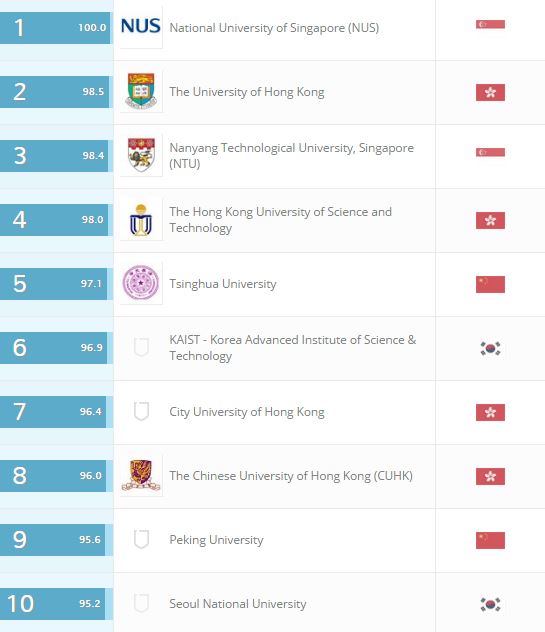THE National University of Singapore (NUS) continues to reign supreme among higher education giants in Asia, clinching the top spot in the QS Asia University Rankings for the third consecutive year.
NUS president Tan Chorh Chuan told the Straits Times that strong government support has encouraged local universities to push for excellence.
“At NUS, our priority is in preparing future-ready graduates and developing top talent, driving innovation and forging strategic collaborations with academic and industry partners, and delivering impact from world-class research,” he said.

QS University Rankings: Asia 2016. Image via topuniversities.com
The 2016 ranking, which was released on Tuesday, also saw another Singaporean university, Nanyang Technological University (NTU), take third place, moving one spot up from the previous year.
In the QS World University Rankings 2015/16, NUS and NTU are ranked at #12 and #13, respectively.
NUS attained a perfect score in four metrics: academic reputation; employer reputation; citations per paper; and international faculty.
NTU also got a perfect score in four metrics: employer reputation; citations per paper; international faculty; and the proportion of outbound exchange students.
However, Hong Kong universities dominate the top 10, with four institutions listed among Asia’s academic cream of the crop – the University of Hong Kong (#2); the Hong Kong University of Science and Technology (#4); City University of Hong Kong (#7); and the Chinese University of Hong Kong (#8).
SEE ALSO: Singapore leads Asia in QS World University Rankings 2015
London-based education and career consultancy Quacquarelli Symonds (QS) said for this year, it expanded the top Asian universities list to include the region’s 350 best universities – 50 more than last year.
In order to measure excellence among Asian universities, QS uses 10 key performance indicators to compare institutions, including academic reputation, employer reputation, faculty-student ratio, papers per faculty, the proportion of international faculty and students, and proportion of inbound and outbound exchange students.
For 2016, QS included a new metric – staff with a PhD – in order to add another dimension to its analyses of teaching quality.
Alongside the Asian rankings, QS released the top university lists for the Latin America, Arab, and Emerging Europe & Central Asia (EECA) regions.
The post Singapore’s NUS ranked Asia’s top university for third consecutive year appeared first on Asian Correspondent.




